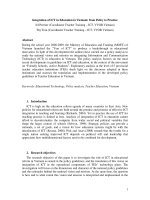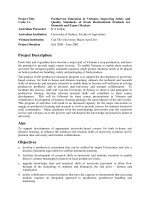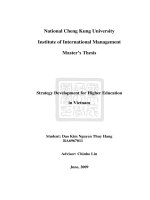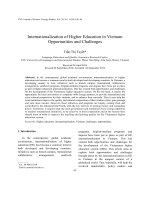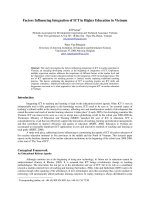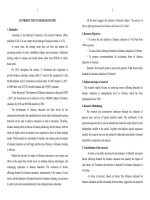Sex education in vietnam
Bạn đang xem bản rút gọn của tài liệu. Xem và tải ngay bản đầy đủ của tài liệu tại đây (222.87 KB, 36 trang )
Topic: Awareness of students in Nguyen Chi Thanh high school about sex education.
Abstract
The paper presents that sexual education in schools is really necessary instead of letting
children find out by themselves with unreliable sources. There have been many cases out there
about sexual transmitted diseases and teenagers still having sexually active no matter that we
have taught them or not. The fact that, sex education in Vietnam is still a sensitive issue that
rarely mentioned. Obviously, there are still sex education programs at school, but most are
taught sketchily, and so forth they cannot satisfy the students' knowledge demand. It draws the
attention to the schools, for the reason that the education system will do this better than parents,
who are not strong enough in sexual knowledge. Comprehensive sex education doesn't
encourage kids to have sex, the more kids know, the more likely they are to say no. This study
use survey method to analyze sex education is very needed be in schools. The research is of
interest to students in Nguyen Chi Thanh high schools, because at that age students have grown
up and needed to know more about sex education. But the most importantly, they need to know
how to avoid unfortunate cases in many situations.
1
List of Abbreviation
Comprehensive sexuality education: CSE
Intrauterine device: IUD
Nguyen Chi Thanh: NCT
Sexual and reproductive health: SRH
Sexually transmitted diseases and infections: STIs
United Nations Population Fund: UNFPA
2
List of Charts
Chart 1: Number of pupils has heard about sex education before
Chart 2: Number of pupils said that sex education was necessary
Chart 3: The number of pupils if they have learned about sex education at school
Chart 4: The proportion of pupils if they found those sex education courses at school useful
Chart 5: Proportion of pupils think sex education should be taught elaborate at high school
3
Table of Contents
Topic: Awareness of students in Nguyen Chi Thanh high school about sex education...................1
Abstract............................................................................................................................................1
List of Abbreviation.........................................................................................................................2
List of Charts....................................................................................................................................3
Chapter 1: Introduction....................................................................................................................5
1.1 Background of the research...................................................................................................5
1.2 Problem statement..................................................................................................................5
1.3 Research objectives................................................................................................................6
1.4 Research methodologies........................................................................................................6
1.5 Scope and limitation..............................................................................................................7
Chapter 2: Literature Review...........................................................................................................8
2.1 Related theories:.....................................................................................................................8
2.1.1 Definition:.......................................................................................................................8
2.1.2 Impacts on human life:....................................................................................................9
2.1.3 Impacts on students’ life:..............................................................................................10
2.2 Results from previous studies:.............................................................................................11
Chapter 3: Findings and Discussion..............................................................................................13
3.1 Result of the finding:...........................................................................................................13
3.2 Discussion and evaluation of the findings:..........................................................................14
3.3 Solution:...............................................................................................................................24
3.3.1 Solution from the people surveyed:..............................................................................24
3.3.2 Solution from the author:..............................................................................................24
Chapter 4: Conclusion and recommendation.................................................................................25
4.1 Limitation:............................................................................................................................25
4.2 Recommendations:...............................................................................................................25
4.3 Conclusion:..........................................................................................................................25
Timelines........................................................................................................................................27
Reference.......................................................................................................................................28
Appendices.....................................................................................................................................30
Appendices A:............................................................................................................................30
Appendices B:............................................................................................................................34
4
Chapter 1: Introduction
1.1 Background of the research
There's nothing simple to teaching kids about sex, especially in times of precocious pre-teens,
pregnancy among teenagers, and sexually transmitted diseases and infections (STIs), children
and adolescents need much more than a one-time chat about “the birds and the bees” (Boskey,
2019). “Angus Reid Public Opinion” asked adult respondents to look back to the time when
they were teenagers, and describe how useful several sources were in enabling them to learn
more about sex and half of Canadians and Americans found their sex education courses at
school to be useful (Canseco, 2011). However, some surveys said that more than half of parents
do not think sex education should be taught to children at school (Daily Mail Reporter, 2011).
Meanwhile, only about 33% of high schools in Vietnam have included sex education in
curriculum for students (Nguyen, 2012). The aim of the current study was to examine how
parents, schools and children countenance sex education programs at schools in Vietnam. The
study examined the view of students on sex education of Nguyen Chi Thanh (NCT) high
schools.
1.2 Problem statement
For a long time, the issue of sex education in Vietnam is still had its limits. Parents are always
embarrassed to mention this issue with their children, especially when their children reach
puberty. Not to mention that parents do not have enough knowledge to teach their children. The
“Tien Phong” newspaper on 2013 has reported that with an average of 300,000 abortions each
year, from aged 15-19, of which 60-70% is students from high schools and universities.
5
Vietnam is still the country with the highest adolescent abortion rate in Southeast Asia and fifth
in the world. Hence, sex education at school is really necessary since physiology and sexuality
are inevitable, someone must have to guide students in the right direction, instead of letting
children have no answer. The Internet is one of the place for students to learn about these issues,
but not all of them are correct and positive, without a proper orientation, they will fall easily.
1.3 Research objectives
The aim of the current research was to explore gender education in high schools. Schools
should not only improve knowledge but also set up life skills for students. It is also to study
about the lack of gender education in high school. There are very few schools nationwide
required sex and health education for graduation. Furthermore, the most important goal of this
research is, strongly support sex education in schools. Extracurricular sessions, seminars on
love and gender shall be organized regularly and more effectively for children to actively
participate, work, learn in a scientific way and improve their ideas “How to build a positive
lifestyle for them”. Moreover, support gender education in school could help students to aware
about STIs and many problems (for example: HIV, AIDS, unwanted pregnancy…)
1.4 Research methodologies
The research method of this paper is using questionnaire and face-to-face survey method. The
questionnaire consists of 15 questions, including many types: closed-ended questions, likert
scale questions, opinions questions, checkbox questions and multiple-choice questions. In
particular, the questionnaire comprises these parts: 4 filter questions formatted as “yes or no”; 4
likert scale questions to get exactly attitudes and opinions of the people surveyed; 3 opinion
6
questions to know students perspective in the wording of their choice; 8 multiple choice and
checkbox questions in order to get more student’s aspect. The researcher uses this method with
the purpose to get information, opinions from students of the NCT high school and how they
acknowledge about sex education.
1.5 Scope and limitation
The research was conducted with the support from pupils of NCT high school, located in Tan
Binh District, Ho Chi Minh City. The article is limited in time and squarely in one school - to be
more precise, in 2 classes - so the value of this research only reflects the state of sex education
deficiency in NCT high school.
7
Chapter 2: Literature Review
2.1 Related theories:
2.1.1 Definition:
Comprehensive sexuality education (CSE) is a curriculum-based process of teaching and
learning about the cognitive, emotional, physical and social aspects of sexuality. It aims to equip
children and young people with knowledge, skills, attitudes and values that will empower them
to realize their health, well-being and dignity; develop respectful social and sexual
relationships; consider how their choices affect their own well-being and that of others; and
understand and ensure the protection of their rights throughout their lives. (UNESCO, 2018)
Sex education is high quality teaching and learning about a broad variety of topics related to sex
and sexuality, exploring values and beliefs about those topics and gaining the skills that are
needed to navigate relationships and manage one’s own sexual health. (Planned Parenthood
Federation of America)
Burt (as cited in Mare, 2008, p.7) defined sex education as the study of the characteristics of
beings: a male and female. Such characteristics make up the person's sexuality. Sexuality is an
important aspect of the life of a human being and almost all people, including children, want to
know about it.
Comprehensive sex education includes all the educational measures which regardless of the
particular method used - may center on sex. Furthermore sex education stands for protection,
presentation extension, improvement and development of the family based on accepted ethical
ideas. (Hopician)
Thus, sex education may also be described as "sexuality education", which means that it
encompasses education about all aspects of sexuality, including information about family
8
planning, reproduction (fertilization, conception and development of the embryo and fetus,
through to childbirth), plus information about all aspects of one's sexuality including: body
image, sexual orientation, sexual pleasure, values, decision making, communication, dating,
relationships, sexually. (Mare, 2011, p.7)
2.1.2 Impacts on human life:
De (2011) concludes that it is important that youngsters should understand what sex is and how
it determines their life. They must be taught about the difference between a good touch and bad
touch at an early age, so that they can prevent the advances made by pedophiles or can at least
inform elders about any incident that upsets them. Awareness is a key benefit of early sexual
education.
Too many young people receive confusing and conflicting information about relationships and
sex, as they make the transition from childhood to adulthood. When delivered well, sexual and
reproductive health (CSE) responds to this demand, empowering young people to make
informed decisions about relationships and sexuality and navigate a world where gender-based
violence, gender inequality, early and unintended pregnancies, HIV and other STIs still pose
serious risks to their health and well-being. Equally, a lack of high-quality, age- and
developmentally-appropriate sexuality and relationship education may leave children and young
people vulnerable to harmful sexual behaviors and sexual exploitation. (UNESCO, 2018)
SRH encompasses dimensions of physical, emotional, mental and social well-being in relation
to sexuality; it is not merely the absence of disease, dysfunction or infirmity. Healthy habits,
and the understanding of how to maintain good health, begin in early childhood. Adolescence is
an opportune time to build healthy habits and lifestyles relating to SRH, as it is a period of
ongoing physical, emotional and social change, as well as the period when many individuals
9
will start exploring their sexuality and developing relationships with others. (UNESCO, 2018)
2.1.3 Impacts on students’ life:
Sex education programs often include significant coverage of various types of STIs. For many
students, this is the first time they go through a thorough review of causes and results of STIs.
In the same health classes, many sex education teachers also promote anatomy awareness about
the biological side of sex so students are more aware of their own bodies. Regardless of the
overall teaching philosophy, STIs awareness can either help motivate student abstinence
through the sheer fear of catching STIs. Students that still have sex receive information about
taking precautions when engaging in sexual behavior to prevent the transmitted diseases. Teen
pregnancy is a major concern in high schools and homes across America. A correlation often
exists between the amount of education and the rate of teen pregnancy. (Kokemuller, 2018)
Rubin and Kindendall expressed that sex education is not merely the topics of reproduction and
teaching how babies are conceived and born. Instead, it has a far richer scope and goal of
helping children incorporate sex more meaningfully into their present and future life and to
provide them with some basic understanding of virtually every aspect of sex by the time they
reach full maturity (as cited in Mare, 2008, p.7)
A 2010 review found that “gender-focused” curricula – meaning curricula that integrate gender
equality into the learning material – were substantially more effective in reducing risky
behaviors than programmes that did not consider gender. Research has also shown that delay in
sexual initiation, use of condoms and practice contraception has been a result of young people
adopting egalitarian attitudes about gender roles. These individuals were also found to be less
likely engaged in violent relationships and have a lower rate of STIs including HIV and
unintended pregnancy. (UNFPA, 2014)
10
Various aspects of sex education should be taught in school depending on the age of the
students or what the children are able to comprehend at a particular point in time. Rubin and
Kindendall (2001) expressed that sex education is not merely a unit in reproduction and
teaching how babies are conceived and born. It has a far richer scope and goal of helping the
youngster incorporate sex most meaningfully into present and future life, to provide with some
basic understanding on virtually every aspect of sex by the time reach full maturity. (Mare,
2011, p.7)
2.2 Results from previous studies:
Jeanette De La Mare’s research paper examines the ways in which schools are addressing a
provision in the Educational Act that allows parents to withdraw their children from the
sexuality education parts of health education. To look at the proportion of students withdrawn
and if schools are making parents aware of the provision. Schools were aware of the issue that
puberty was becoming an issue with children at a younger age than 11 years now days but most
chose to leave puberty issues with parents of those more developed children. The author states
that CSE is positively influential on every individual, but especially essential for children to
insulate against the sexual violence, STIs, and so on.
UNFPA Operational Guidance for CSE guide that the right of access to CSE is grounded in
fundamental human rights and is a means to empower young people to protect their health,
well-being and dignity. It is also linked with the other four prongs, which are focused on:
evidenced-based advocacy for development, investment and implementation; building capacity
for sexual and reproductive health service delivery, including HIV prevention, treatment and
care; bold initiatives to reach the most vulnerable; and youth leadership and participation. The
11
author affirms that it sketch steps to analyze priorities, achieve actions and appraise outcomes –
afford tools for programme managers and technical advisers.
Jessica Hausauer’s study examine what exactly parents are teaching their children. Her study
found that the research regarding parents and children’s conversations about sex was lacking.
Many of the studies were outdated or used questionable research methods. The main purpose of
Hausauer’s research project is to examine the experience of parent to child communication
about sex. The author states that the study scratches the exterior when it comes to learning about
what parents are teaching their children about sex. The point to understanding parent to child
communication about sex would be determined what children are actually getting from
conversations.
Caitlin Motherway’s study examine that sex education has the potential to be a powerful way to
educate children and adolescents about the risks and implications of sex. There are an alarming
number of children and adolescents dealing with the consequences of defenseless sex, so sex
education programs that reduce this number most constructively should be conveyed to students
in schools. The author states that the study was to show that students, who gained
comprehensive-based sex education in high school, contrast to those who received abstinenceonly sex education, would be more knowledgeable about, and practice, safe sex.
12
Chapter 3: Findings and Discussion
3.1 Result of the finding:
The survey sample has a total of 55 samples, including 20 males and 35 females’ students,
within this sample 91% of the respondents said they have heard about sex education program
before and 8% said they have never heard about that. Among 91% that have heard about sex
education before, female students known about sex education before take more than 2 times
higher than male students while the female student did not know about sex education before
only 2%, which was 4 times lower than male students. Almost students agree that sex education
is really necessary; only 6% male students do not agree that statement.
Another question with the purpose of surveying whether schools have organized a sex education
program for students, and more than a half of students said yes, and 67% said those courses
useful while 5% of female said those sexuality education program was not useful for them;
others was have not been taught about sex education before. Most students have been taught sex
education at school rated the program as good and somewhat well and more than a half of
students agree that sex education should be taught elaborate at high school. On the other hand,
students still cannot distinguish between CSE and “sex education is just connives and condone
for children”.
Nearly a half of students have no idea with the state said “The education system in Vietnam is
not ready for sex education”. But if the system are good enough to teach sex education, so why
does it not satisfy the curiosity of the students? The answers was chosen by the majority were
because parents and teachers so shy to teach students, and because other subject like math,
literature, physics, … are more importance than gender education programs.
On the whole, the author admits that those results, which are obtained, are very objective.
13
Simultaneously, reflect the sex education problems in schools nowadays and can interpret the
feeling of students with sex education.
3.2 Discussion and evaluation of the findings:
The first question ask if students have ever heard about sex education before, 91% of students
answer “yes” while the rest answer “no”. Looking at chart 1: “Number of pupils has heard about
sex education before”, for more detail, female students have heard about sex education before
was over 60%, which was over 2 times higher than male students, with fewer than 30%. While
female students have not heard about sex education before was only 2%, which were fewer than
male students 4 times.
The second question only asks those pupils have heard about sex education program before if
they think sex education is necessary, as can be seen from chart 2: “Number of pupils said that
sex education was necessary”, 94percent of pupils agreed that sex education is essential for each
14
students while 6 % of pupils refuse the statement. Looking at the chart in more detail, number
of male pupils, which was 26%, agrees sex education is necessary lower than female. It is also
noticeable that all female students, which were 68%, admitted that sex education was extremely
important for individual students.
The third question asks the pupils if they have learned about sex education at school. Looking at
chart 3: “The number of pupils if they have learned about sex education at school” for more
detail. The proportion of female students has learned about sex education at school was 52%,
higher than the proportion of female students has not learned about sex education at school,
which was 16%. In contrast, the percentage of male students has learned about sex education at
school was 14%, which was lower than 18% - the percentage of male students has not learned
about sex education at school.
15
The forth question only asks the pupils if they found sex education courses at school might be
helpful for them. Overall, 64% of students said “yes” with the question, 6% of them said “no”
and the others said they haven’t learned at school. According to chart 4, it is clear that the figure
of female students found those sex education courses at school useful was the highest with 46%.
On the contrary, 6% of female students said the sex education lectures at school did not satisfy
their curious. It is also noticeable that there was not a single person of male students found sex
education courses at school ineffective while the proportion of male students found sex
education courses at school useful and the proportion of male students have not learned about
sex education at school equalizer, which was 18% for both.
16
Through 4 questions above, the author states that female pupils are care and know about sex
education more than male pupils. This is a good sign for the reason that schoolgirls’s knowlegde
can protect themselve from problems.
The 5th question asks the pupils to rate the sex education programs at school. The result obtained
said that the highest proportion was 28% came from “fair” answer, which was higher than “bad”
answer with only 6%. The second highest proportion was 22% of “good” answer which was
over 11 times higher than “very bad” answer. The third highest proportion was 12% of “very
good” programs of sex education, and the others was 30% of the pupils have not learned sex
education from school.
From the 6th to 8th question is a statement to survey how students agree or disagree with that
opinions. The 6th question states that “I think sex education should be taught elaborate at high
school”. More than a half of students “Strongly agree” with the statement, which was 54%, is
twice as high as “Undecided” answer with 24%. As can be seen from the chart the answer
“Disagree” has very small percentage – 2% while the other answer, which was “Strongly
17
disagree” answer has 0% in the chart.
The 7th question states that “Sex education is just connives and condone for children”. The most
chosen answer was “Undecided” with over than a half - 56%, while “Strongly agree” answer
only 2%. It is also perceptible that “Disagree” answer was 34% and “Strongly disagree” answer
was 6%. The other answer was “Agree” have been not selected.
The final likert scale question is the 8th question states “The education system in Vietnam is not
ready for sex education”. Nearly a half of students chose “Undecided” with 44%, which was
twice as high as “Disagree” with 22% answer while “Strongly disagree” answer was 18%, and
the opposite answer - “Strongly agree” - with 4%, nearly half as many percentage as “Agree”
answer.
The 9th question is an opinion – question asks whether they think sex education should be taught
18
at schools and the reason why. 90% of students have the same opinions said that sex education
should be taught at school for various reasons. Nearly a half of students, which was 49%, said
should teach sex education at school because it can provide knowledge, extend many ways to
prevent accidentally happening and know how to keep them out of trouble. It is also because
students will be curious, which leads to many pupils with misconceptions and lack of
understanding of sexual needs and changes of the body. The second highest percentage was
26% of students, have opinion that sex education should be taught at school for the reason that
it very essential for each students while 6% of students said because sex education help students
to reduce adolescent abortion. 5% of students agree school to teach sex education since they
would like to learn more about sex education. Another 4% of pupils agree as it helps students to
distinguish more clearly gender. In contrary, 8% of students said that they have no idea with the
question, and only 2% said that sex education shouldn’t be taught at school since no one care
about it.
The 10th question asks for the reason why schools and parents did not concentrate in sex
education. 2 answers have the highest percent chosen by student was for “Because
embarrassment” and “Because other subjects are more important”, which was 28% for each
answer. “Because students will find out for themselves” and “Because schools and parents not
having enough expertise” was equalize with 4%. Among those answer, there are plenty of
students choosing many answers at the same time. Particularly, 12% of students chose 2 answer
at the same time, which was 4% chose “Because embarrassment” and “Because schools and
parents not having enough expertise” while 4% of students chose “Because embarrassment” and
“Because other subjects are more important”, 2% of students chose “Because students will find
out for themselves” and “Because other subjects are more important” and 2% of students chose
19
“Because other subjects are more important” and “N/A”; 16% of students chose 3 or more than
3 answers, which was 4% chose all the answer except “N/A”, 2% chose “Because
embarrassment”, “Because students will find out for themselves” and “Because other subjects
are more important” while 4% of students chose “Because embarrassment”, “Because schools
and parents not having enough expertise”, “Because other subjects are more important” and
“N/A”. It is also noticeable that 2% of students chose “Because embarrassment”, “Because
schools and parents not having enough expertise” and “Because other subjects are more
important” while 2% of students chose “Because embarrassment”, “Because other subjects are
more important” and “N/A”. The last is 2% of students chose all the answer. For the “N/A”
answer of question number 10, 8% of students chose this. Specifically, 8% for 4 answers have
been written: 2% of students wrote that sex education is not important enough to be taught
while the others wrote that the reason why sex education did not concentrate by school is the
failure to create cooperation between the students and the teachers, another 2% was the students
have no idea with the question, and the last answer is because students still teenager, they don’t
need to know about sex education. The answers from the 10% of students who chose more than
1 or 2 answers also written in this, particularly, 6% of student said that because parents think
their child still young, no need to know about this, so they don’t even care about those courses.
Another 2% of students wrote that because the functional and consciousness base in Vietnam is
still limited, the government wants to deny the problem about sex education.
The 11th the question asks where they found out about sex education. The highest proportion
was 28%, which mean 28% of students was found out about sex education on “Social network”
while students found out about sex education from “Friends” only have 4%. Among that
percentage of students found out about sex education from “Family” was 12%, which was lower
20
than “N/A” answer with 14%. Among those answer, there are plenty of students choosing many
answers at the same time. Particularly, 20% of students chose 2 answers at the same time, which
the percentage of students chose “Social network” and “Friends” was 12% while the number of
students chose “Friends” and “Family” was 6% and the proportion of the students chose
“Family” and “N/A” was 2%. Furthermore, 22% of students chose more than 2 answers at the
same time, which was 14% of pupils chose all the answers except “N/A” while 4% of pupils
chose “Social network”, “Friends” and “N/A”. It is also noticeable that 2% of pupils chose
“Social network”, “Family” and “N/A” and 2% of pupils chose all the answers. For the “N/A”
answer of question number 11, 14% of pupils chose this. In particular, 10% of pupils wrote that
they was found out sex education from the special subjects, seminars at schools while 2% of
pupils wrote that they have not care about sex education before, and 2% said that they did not
use anything to find out about sex education. The answers from the 10% of students who chose
more than 1 or 2 answers also written in this, to be more precise, 6% also from school, 2% said
students know about sex education through flicks, movies; and the last 2% said that they
learned from foreign books because abroad people are more easy-going with sex education.
The 12th asks for how many ways are there to the highest percent chosen by student was for “3
ways” with 46% while “2 ways” was only 18% and “1 way” have no percentage. “N/A”
answers had the second highest proportion with 36%, among that, 12% of students said that
they did not know about any way, 18% said that there was a lot of ways to protect, which was
using condom, daily contraceptive pill, Intrauterine device (IUD), contraceptive implants,
contraceptive patches,… And the others said that there was 4 to 5 ways to defend against bad
situations.
The 13th question asks for the way which safest for both when having sexual intercourse. The
21
first answer “Use birth control pills” with 10% of students chose this, which was not as high as
the “Use condom” answer with 52%. It is also noticeable that the percentage of “Use
Intrauterine device” higher than “Use birth control pills”, which was 12%. It is prove that
students know emergency contraceptive pills can have lot of problem to the female, and even
daily contraceptive pills can cause lot of symptom for the female body. Moreover 10% of
student chose “N/A” answer. Among those answer, there are plenty of students choosing many
answers at the same time. Particularly, 12% of students chose 2 answers at the same time, which
was 6% of student, chose both “Use birth control pills” and “Use condom”, 4% of students
chose “Use condom” and “Use Intrauterine device”, and 2% of student chose “Use Intrauterine
device” and “N/A”. In addition, 4% of students chose more than 2 answers at the same time,
particularly, 2% of student chose all the answers except “N/A” while 2% remaining chose all
the answers. For the “N/A” answer of question number 12, 4% of students said that they do not
know of any way, while 4 other percent of students said that students should not have sexual
intercourse before 18. Also, 4% of students wrote that it depend on each individual and 2%
wrote that There was no safest way, more over using emergency contraceptive pills can cause
infertility.
The 14th question asks what students should do if they or their friends unfortunately have
sexually transmitted infections. The most written answer with 38%, was suggest that students
should go to hospital and get doctor’s advises for the disease. The second most written answer
with 24%, which was recommend that students should immediately contact to parent or relative
for assistance, as well as be able to promptly handle and get the best provide guidance while
18% has the answer similarly with both above answer, which suggest that students should
immediately contact to parents and go to the hospital for the best treatment. 4% of student said
22
that should confess with the homeroom teacher to have the right guidance before everything
was too late. Moreover, 8% cared about the spirit of the patient more than others while another
2% of students said that the government should provide financial support and also ensure
patient morale. 2% said that the treatment depends on how serious case of the disease and 4%
wrote that they do not even know.
The 15th question asks what students should do if the girl have unwanted pregnancy. The most
written answer with 32% of telling to student’s parents to have the right solutions, among them,
10% of students should be responsible for their actions while 10% of students depending on the
solution from the family and relatives. What’s more, 10% of students suggest that the female
should abortion because they have to continue the learning process in school, among that, 2% of
students said that the female should abortion with medication while 8% of students confused
between pregnancy and abortion. 6% of students suggest that students should confess with the
homeroom teacher to have the right guidance, 2% of them said that should not abortion. Only
4% said that the female student need to tell the family, if family is eligible, it is best to keep the
children because if the girl decide to abortion, the possibility of infertility would increase, so it
very difficult to be pregnant again. About the male, he should be responsible for what he did,
inform the family to get the best advice.
The problem of sex education about “lacking of sex education in Vietnam” was found out at the
question number 3, with only 30% of “students who have not learned about sex education
before”, it mean more than a half of students, which was 70%, have learned about it before so it
not mean “lacking” in sex education at school. However, the qualities of sex education
programs at school are not satisfy the curious of students, some of it not even useful for them.
Moreover, “sexuality education is necessary for children” were exactly with most students
23
agreed with that state while some parent did not care about that. Leads to the result that many
students did not know what to do when they had problem about sexuality disease or unwanted
pregnancy …
3.3 Solution:
3.3.1 Solution from the people surveyed:
The best solution about sex education in Vietnam from the people surveyed was supported the
school to teach CSE, especially more detail than present sex education programs, more
practical, not just theories about the human body
3.3.2 Solution from the author:
CSE should be taught at school, for example: how to prevent pregnancy, which one is the safest
way to prevent pregnancy, when people should have sexual intercourse, how to avoid STIs…
Not only taught ways to prevent it, school must also instruct what students should do if they
unfortunately meet the problem.
24
Chapter 4: Conclusion and recommendation
4.1 Limitation:
The difficulty when the author implements this research is the time taken for the survey was too
short, resulting in insufficient time to classify responses. Especially the questions that allow
students to choose more than 1 answer were the most time – spending of all the research. The
other problem was the question number 6 “I think sex education should be taught elaborate at
high school” and number 9 “Do you think sex education should be taught in schools? Why?”
were mostly similar. The question number 12 was not clearly, instead of ask “How many ways
to avoid unfortunate problem when have sexual intercourse?” the question should be changed to
“How many ways to avoid unfortunate problem when have sexual intercourse and listed it?”
However the author has analyzed the questions in a logical manner and still completed the
research in time.
4.2 Recommendations:
Recommendations for the following research paper are the author should start the survey earlier
in order to have more time to analyze the responded of people surveyed. Another suggests that
the checkbox questions should be fewer therefore the author can have more time to examine the
responded more carefully.
4.3 Conclusion:
Generally, the research has examined about sex education at school in Vietnam, in order to find
out 2 problems “Sexuality Education is necessary for children” and “Lack of sex education
programs at schools”. The first problem was discussing successfully with mostly of people
surveyed agree with the statement in the questionnaire. The second problem was also having
good result, however there a lot of different opinions about the qualities of sex education
25
